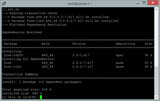Install Plesk on CentOS 7
Using a Different System? Plesk is a proprietary web host control panel that allows users to administer their personal and/or clients websites, databases
Cuberite is a scalable, open-source Minecraft server implementation that is written in C++. It has an easy-to-use plugin system that allows for users to write custom plugins with Lua and was originally created under the MCServer name.
Cuberite is multi-platform and will work with most Linux operating systems and Windows. This tutorial will only cover the installation of the server software on a CentOS 6 or 7 installation. Like most Minecraft servers, plugins and other factors will contribute to a larger memory footprint. To start off, it is suggested that you have at least:
Vultr offers these specifications for $5 per month (including 25 GB of SSD and a terabyte of bandwidth).
Before we begin, we have to make sure that the system is up to date and that we have an appropriate text editor. This will be necessary for configuring the server. We will also need the appropriate tools to build and compile the software.
Before we install anything, execute the command below to update your system:
yum update -y
Now, we will install nano. (you may use vim or any other editor you prefer):
yum install nano -y
Once it finishes, run the following command to install cmake (the compiler):
yum install cmake -y
Now, install screen (allows applications to run in the background):
yum install screen -y
After screen installs, you can proceed to the next section.
Now that we have all the dependencies required for the installation to complete, we must retrieve the script. The commands below will create a new directory in /root, or ~.
cd ~ && mkdir server
cd server
wget -O install.sh https://compile.cuberite.org
Now, you can run the installation script:
sh install.sh
You will see the following message in your terminal:
[root@demo server]# sh install sh
Hello, this script will download and compile Cuberite.
On subsequent runs, it will update Cuberite.
The compilation and download will occur in the current directory.
If you're updating, you should run: <Path to Cuberite>/compile.sh
Compiling from srouce takes time, but it usually generates faster
executables. If you prefer ready-to-use binaries or if you want
more info, please visit: https://cuberite.org
Choose compile mode:
* (R)Release: Compiles normally.
Generates the fastest build.
* (D)Debug: Compiles in debug mode.
Makes your console and crashes more verbose.
A bit slower than Release mode. If you plan to help
development by reporting bugs, this is preferred.
Choose compile mode: (r/d) (Default: "Release"):
When you see the above, just hit ENTER on your keyboard.
You will now see the following:
Choose the number of compilation threads.
You have 2 CPU threads.
If you have enough RAM, it is wise to choose your CPU's thread count.
Otherwise choose lower. Old Raspberry Pis should choose 1. If in doubt, choose 1
.
Please enter the number of compilation threads to use (Default: 1):
You may choose to use more threads for the compilation (depending on the instance you have). Apart from this, all you have to do is hit ENTER.
Once you've done so, you will be prompted with following message:
#### Settings Summary ####
Build Type: Release
Branch: master (Currently the only choice)
Compilation threads: 1
CPU Threads: 2
Previous Compilation: Not detected. We are assuming this is the first compile.sh run.
Upstream Link: https://github.com/cuberite/cuberite.git
Upstream Repo: origin
After pressing ENTER, the script will connect to https://github.com/cuberite/cuberite.git
to check for updates and/or fetch code. It will then compile your program.
If you compiled before, make sure you're in the proper directory and that "Previous
compilation" is detected.
Press ENTER to continue...
This is the final step before the compilation will start. You will be told to hit ENTER to start the compilation. It will take roughly 15 minutes, depending on your system.
NOTE: Don't be alarmed if you see a bunch of text scrolling on your terminal. It will take some time for the system to fully compile the software into an executable package.
Once it completes, you will be greeted with the following message:
-----------------
Compilation done!
Cuberite awaits you at:
/root/server/cuberite/Server/Cuberite
You can always update Cuberite by executing:
/root/server/cuberite/compile.sh
Enjoy :)
This marks the end of the installation. You can proceed to the next section for the configuration of the server.
To configure your server, we must first locate and copy the compiled server out of our temporary directory:
cd cuberite
cp -r Server ~/server/cuberiteServer
cd ./cuberiteServer
Your server directory will now be located at /root/server/cuberiteServer and the configuration file will be located at /root/server/cuberiteServer/settings.ini.
We can now edit the configuration using any text editor:
nano settings.ini
You will see something that looks like the following:
[Server]
Description=Cuberite - in C++!
ShutdownMessage=Server shutdown
MaxPlayers=100
HardcoreEnabled=0
AllowMultiLogin=0
Ports=25565
In order to edit the maximum number of players that can be online at any given time, just modify the MaxPlayers=100 line to any number you desire.
For example, if you wanted a maximum of 25 players, all you'd have to do is change the line to MaxPlayers=25.
You can also change the port, but it is not recommended because of the increased difficulty for users to connect to your server (the default port for Minecraft servers is 25565).
If you're using nano, you can exit and save by doing CTRL + X, followed by ENTER.
To start the server, simply head to the server directory (/root/server/cuberiteServer) and start a screen:
cd ~/server/cuberiteServer
screen -S MinecraftServer && screen -r MinecraftServer
You can reconnect to the screen at any given time using the screen -r <screenName> command. We named the screen MinecraftServer, so reconnecting can be done by performing screen -r MinecraftServer.
Now, execute the server binary:
./Cuberite
It may take a few seconds for the terrain to generate before the server can be used. Also, use the following combination to exit the screen: CTRL + A + D.
In order to perform a hard-shutdown, all you need to do is use CTRL + C. To perform a graceful shutdown, enter the following command in the console:
stop
Assuming that you've already configured the firewall, you can enter your server address in the Minecraft client.
Your address should look like the following: 192.0.2.5:25565 (192.0.2.5 being your actual server address).
At this point, you can pass your server address along with a few friends and start building.
Removing the software is simple. All you have to do is make sure that the server is offline and run rm -rf ~/server.
Using a Different System? Plesk is a proprietary web host control panel that allows users to administer their personal and/or clients websites, databases
Squid je populárny bezplatný linuxový program, ktorý vám umožňuje vytvoriť webový proxy server na presmerovanie. V tejto príručke uvidíte, ako nainštalovať Squid na CentOS, aby vás zmenil
Úvod Lighttpd je fork Apache, ktorého cieľom je byť oveľa menej náročný na zdroje. Je ľahký, odtiaľ jeho názov, a jeho použitie je celkom jednoduché. Installin
VULTR nedávno vykonal zmeny na ich konci a všetko by teraz malo fungovať dobre po vybalení so zapnutým NetworkManagerom. Ak chcete deaktivovať
Icinga2 je výkonný monitorovací systém a pri použití v modeli master-client môže nahradiť potrebu monitorovacích kontrol založených na NRPE. Hlavný klient
Používate iný systém? Apache Cassandra je bezplatný a otvorený systém správy databáz NoSQL, ktorý je navrhnutý tak, aby poskytoval škálovateľnosť, vysokú
Používate iný systém? Microweber je open source drag and drop CMS a online obchod. Zdrojový kód Microweber je umiestnený na GitHub. Tento návod vám to ukáže
Používate iný systém? Mattermost je open source, samostatne hosťovaná alternatíva k službe posielania správ Slack SAAS. Inými slovami, s Mattermostom môžete cca
Čo budete potrebovať Vultr VPS s aspoň 1 GB RAM. Prístup SSH (s oprávneniami root/administrátor). Krok 1: Inštalácia BungeeCord Najprv veci
Ovládací panel Plesk obsahuje veľmi peknú integráciu pre Lets Encrypt. Lets Encrypt je jedným z mála poskytovateľov SSL, ktorí rozdávajú kompletné certifikáty
Lets Encrypt je certifikačná autorita, ktorá sa venuje bezplatnému poskytovaniu certifikátov SSL. cPanel vytvoril úhľadnú integráciu, takže vy a váš klient
Používate iný systém? Concrete5 je open source CMS, ktorý ponúka mnoho charakteristických a užitočných funkcií, ktoré pomáhajú redaktorom jednoducho vytvárať obsah
Používate iný systém? Review Board je bezplatný a otvorený zdrojový nástroj na kontrolu zdrojového kódu, dokumentácie, obrázkov a mnohých ďalších. Je to webový softvér
V tejto príručke sa dozviete, ako nastaviť HTTP autentifikáciu pre webový server Nginx spustený na CentOS 7. Požiadavky Na začiatok budete potrebovať
YOURLS (Your Own URL Shortener) je open source aplikácia na skrátenie adresy URL a analýzu údajov. V tomto článku sa budeme zaoberať procesom inštalácie
Používate iný systém? Úvod ArangoDB je open source databáza NoSQL s flexibilným dátovým modelom pre dokumenty, grafy a hodnoty kľúča. to je
Úvod Adresár /etc/ hrá rozhodujúcu úlohu v spôsobe fungovania systému Linux. Dôvodom je skutočnosť, že takmer každá konfigurácia systému
Mnoho systémových administrátorov spravuje veľké množstvo serverov. Keď je potrebné pristupovať k súborom cez rôzne servery, prihlásenie do každého z nich samostatne ca
Tento tutoriál sa bude zaoberať procesom inštalácie herného servera Half Life 2 na systém CentOS 6. Krok 1: Inštalácia predpokladov Aby ste mohli nastaviť ou
Laravel GitScrum alebo GitScrum je nástroj na zvýšenie produktivity s otvoreným zdrojom určený na pomoc vývojovým tímom implementovať metodiku Scrum podobným spôsobom.
Umelá inteligencia nie je v budúcnosti, je tu priamo v súčasnosti V tomto blogu si prečítajte, ako aplikácie umelej inteligencie ovplyvnili rôzne sektory.
Ste aj vy obeťou DDOS útokov a máte zmätok ohľadom metód prevencie? Ak chcete vyriešiť svoje otázky, prečítajte si tento článok.
Možno ste už počuli, že hackeri zarábajú veľa peňazí, ale premýšľali ste niekedy nad tým, ako môžu zarábať také peniaze? poďme diskutovať.
Chcete vidieť revolučné vynálezy od Google a ako tieto vynálezy zmenili život každého dnešného človeka? Potom si prečítajte na blogu a pozrite si vynálezy spoločnosti Google.
Koncept samoriadených áut vyraziť na cesty s pomocou umelej inteligencie je snom, ktorý máme už nejaký čas. Ale napriek niekoľkým prísľubom ich nikde nevidno. Prečítajte si tento blog a dozviete sa viac…
Ako sa veda vyvíja rýchlym tempom a preberá veľa nášho úsilia, zvyšuje sa aj riziko, že sa vystavíme nevysvetliteľnej singularite. Prečítajte si, čo pre nás môže znamenať singularita.
Spôsoby ukladania údajov sa môžu vyvíjať už od zrodu údajov. Tento blog sa zaoberá vývojom ukladania údajov na základe infografiky.
Prečítajte si blog, aby ste čo najjednoduchším spôsobom spoznali rôzne vrstvy architektúry veľkých dát a ich funkcie.
V tomto digitálnom svete sa inteligentné domáce zariadenia stali kľúčovou súčasťou života. Tu je niekoľko úžasných výhod inteligentných domácich zariadení o tom, ako robia náš život, ktorý stojí za to žiť, a ktorý zjednodušujú.
Spoločnosť Apple nedávno vydala doplnkovú aktualizáciu macOS Catalina 10.15.4 na opravu problémov, ale zdá sa, že táto aktualizácia spôsobuje ďalšie problémy, ktoré vedú k blokovaniu počítačov Mac. Prečítajte si tento článok a dozviete sa viac








